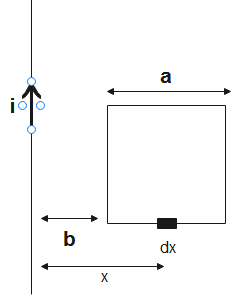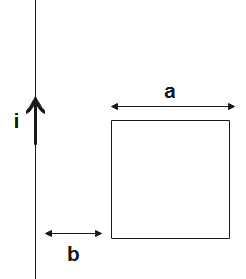Answer
384.3k+ views
Hint: As each element of the square loop is at a different distance from the current carrying wire, flux associated with each will be different. Therefore, we calculate for an element and then integrate it for the whole square. The emf generated is opposite to the direction of current but directly proportional to the rate of change of current.
Formulas Used:
$B=\dfrac{{{\mu }_{0}}I}{2\pi R}$
$\phi =BA\cos \theta $
$e=-\dfrac{d\phi }{dt}$
Complete step-by-step solution:

Let us consider a strip of wire on the square of thickness $dx$. Its distance from the wire is $x$.
When current flows through the wire, a magnetic field is developed around it. The magnetic field intensity, $B$ due to a long wire is given by-
$B=\dfrac{{{\mu }_{0}}I}{2\pi R}$
Here, ${{\mu }_{0}}$ is permeability of free space
$I$ is the current flowing through the wire
$R$ is distance from wire
Therefore magnetic field on strip $dx$ will be-
$B=\dfrac{{{\mu }_{0}}i}{2\pi x}$ - (1)
Flux associated with an area is the number of magnetic field lines associated with it.
Flux,$\phi $ passing through an area is given by
$\phi =BA\cos \theta $
Here, $A$ is the area of cross section
$\theta $ is the angle between area vector and Flux passing through $dx$ is given by-
$\begin{align}
& \int\limits_{0}^{\phi }{\phi }=\int\limits_{b}^{b+a}{B\,(adx)} \\
& \Rightarrow \phi =\int\limits_{b}^{b+a}{\dfrac{{{\mu }_{0}}i}{2\pi x}(adx)} \\
& \Rightarrow \phi =\dfrac{{{\mu }_{0}}ia}{2\pi }\int\limits_{b}^{b+a}{\dfrac{(dx)}{x}} \\
& \Rightarrow \phi =\dfrac{{{\mu }_{0}}ia}{2\pi }{}_{b}^{b+a}\left[ \ln x \right] \\
& \Rightarrow \phi =\dfrac{{{\mu }_{0}}ia}{2\pi }\left[ \ln b+a-\ln b \right] \\
\end{align}$
$\therefore \phi =\dfrac{{{\mu }_{0}}ia}{2\pi }\ln \dfrac{b+a}{b}$ - (1)
Therefore, the total flux associated with the square loop is $\dfrac{{{\mu }_{0}}ia}{2\pi }\left[ \ln \dfrac{b+a}{b} \right]$.
(b). We know that emf induced in the frame is given by-
$e=-\dfrac{d\phi }{dt}$
Substituting values from eq(1), we get,
$e=-\dfrac{d}{dt}\left( \dfrac{{{\mu }_{0}}ia}{2\pi }\left[ \ln \dfrac{b+a}{b} \right] \right)$
Given, $i={{i}_{2}}\cos \left( \dfrac{2\pi t}{T} \right)$ therefore,
$\begin{align}
& e=-\dfrac{d}{dt}\left( \dfrac{{{\mu }_{0}}a{{i}_{2}}\cos \left( \dfrac{2\pi t}{T} \right)}{2\pi }\left[ \ln \dfrac{b+a}{b} \right] \right) \\
& \Rightarrow e=-\dfrac{{{\mu }_{0}}a{{i}_{2}}}{2\pi }\left[ \ln \dfrac{b+a}{b} \right]\dfrac{d}{dt}\cos \left( \dfrac{2\pi t}{T} \right) \\
& \Rightarrow e=-\dfrac{{{\mu }_{0}}a{{i}_{2}}}{2\pi }\left[ \ln \dfrac{b+a}{b} \right]\left( -\dfrac{2\pi }{T}\sin \left( \dfrac{2\pi t}{T} \right) \right) \\
\end{align}$
$\therefore e=\dfrac{{{\mu }_{0}}a{{i}_{2}}\left( \sin \left( \dfrac{2\pi t}{T} \right) \right)}{T}\left[ \ln \dfrac{b+a}{b} \right]$ - (2)
Therefore, the emf induced in the square loop is $\dfrac{{{\mu }_{0}}a{{i}_{2}}\left( \sin \left( \dfrac{2\pi t}{T} \right) \right)}{T}\left[ \ln \dfrac{b+a}{b} \right]$V
(c). the formula for heat is
$H=\dfrac{{{V}^{2}}}{R}dt$
Here, $V$ is the potential drop in the square loop
$R$ is the resistance
Substituting from eq (2), we get,
$\begin{align}
& H=\dfrac{{{e}^{2}}}{r}dt \\
& \Rightarrow H=\dfrac{1}{r}\left( \dfrac{{{\mu }_{0}}a{{i}_{2}}\left( \sin \left( \dfrac{2\pi t}{T} \right) \right)}{T}\left[ \ln \dfrac{b+a}{b} \right] \right)dt \\
& \Rightarrow H=\dfrac{\mu _{0}^{2}{{a}^{2}}i_{2}^{2}}{r{{T}^{2}}}{{\ln }^{2}}\left[ \dfrac{b+a}{b} \right]{{\left( \sin \left( \dfrac{2\pi t}{T} \right) \right)}^{2}}dt \\
& \Rightarrow H=\dfrac{\mu _{0}^{2}{{a}^{2}}i_{2}^{2}}{r{{T}^{2}}}{{\ln }^{2}}\left[ \dfrac{b+a}{b} \right]\left( {{\sin }^{2}}\left( \dfrac{2\pi t}{T} \right) \right)dt \\
& \Rightarrow H=\dfrac{\mu _{0}^{2}{{a}^{2}}i_{2}^{2}4\pi }{r{{T}^{3}}}{{\ln }^{2}}\left[ \dfrac{b+a}{b} \right]\left( \sin \left( \dfrac{2\pi t}{T} \right)\cos \left( \dfrac{2\pi t}{T} \right) \right) \\
\end{align}$
$\therefore H=\dfrac{\mu _{0}^{2}{{a}^{2}}i_{2}^{2}4\pi }{r{{T}^{3}}}{{\ln }^{2}}\left[ \dfrac{b+a}{b} \right]\left( \sin \left( \dfrac{2\pi t}{T} \right)\cos \left( \dfrac{2\pi t}{T} \right) \right)$ - (3)
Therefore, the heat developed in the square loop is $\dfrac{\mu _{0}^{2}{{a}^{2}}i_{2}^{2}4\pi }{r{{T}^{3}}}{{\ln }^{2}}\left[ \dfrac{b+a}{b} \right]\left( \sin \left( \dfrac{2\pi t}{T} \right)\cos \left( \dfrac{2\pi t}{T} \right) \right)$
Therefore by eq(1), eq (2) and eq (3) the flux associated with the square loop is:-
$\phi =\dfrac{{{\mu }_{0}}ia}{2\pi }\ln \dfrac{b+a}{b}$.
Emf developed across its ends is:-
$e=\dfrac{{{\mu }_{0}}a{{i}_{2}}\left( \sin \left( \dfrac{2\pi t}{T} \right) \right)}{T}\left[ \ln \dfrac{b+a}{b} \right]$.
And heat generated is:-
$\dfrac{\mu _{0}^{2}{{a}^{2}}i_{2}^{2}4\pi }{r{{T}^{3}}}{{\ln }^{2}}\left[ \dfrac{b+a}{b} \right]\left( \sin \left( \dfrac{2\pi t}{T} \right)\cos \left( \dfrac{2\pi t}{T} \right) \right)$.
Note:
The direction of magnetic field due to current carrying wire is given by right hand thumb rule. If an area vector of a surface is perpendicular to the direction of magnetic field, there is no flux passing through it. Most of the energy of the square loop developed due to a potential difference at its ends is dissipated as heat.
Formulas Used:
$B=\dfrac{{{\mu }_{0}}I}{2\pi R}$
$\phi =BA\cos \theta $
$e=-\dfrac{d\phi }{dt}$
Complete step-by-step solution:

Let us consider a strip of wire on the square of thickness $dx$. Its distance from the wire is $x$.
When current flows through the wire, a magnetic field is developed around it. The magnetic field intensity, $B$ due to a long wire is given by-
$B=\dfrac{{{\mu }_{0}}I}{2\pi R}$
Here, ${{\mu }_{0}}$ is permeability of free space
$I$ is the current flowing through the wire
$R$ is distance from wire
Therefore magnetic field on strip $dx$ will be-
$B=\dfrac{{{\mu }_{0}}i}{2\pi x}$ - (1)
Flux associated with an area is the number of magnetic field lines associated with it.
Flux,$\phi $ passing through an area is given by
$\phi =BA\cos \theta $
Here, $A$ is the area of cross section
$\theta $ is the angle between area vector and Flux passing through $dx$ is given by-
$\begin{align}
& \int\limits_{0}^{\phi }{\phi }=\int\limits_{b}^{b+a}{B\,(adx)} \\
& \Rightarrow \phi =\int\limits_{b}^{b+a}{\dfrac{{{\mu }_{0}}i}{2\pi x}(adx)} \\
& \Rightarrow \phi =\dfrac{{{\mu }_{0}}ia}{2\pi }\int\limits_{b}^{b+a}{\dfrac{(dx)}{x}} \\
& \Rightarrow \phi =\dfrac{{{\mu }_{0}}ia}{2\pi }{}_{b}^{b+a}\left[ \ln x \right] \\
& \Rightarrow \phi =\dfrac{{{\mu }_{0}}ia}{2\pi }\left[ \ln b+a-\ln b \right] \\
\end{align}$
$\therefore \phi =\dfrac{{{\mu }_{0}}ia}{2\pi }\ln \dfrac{b+a}{b}$ - (1)
Therefore, the total flux associated with the square loop is $\dfrac{{{\mu }_{0}}ia}{2\pi }\left[ \ln \dfrac{b+a}{b} \right]$.
(b). We know that emf induced in the frame is given by-
$e=-\dfrac{d\phi }{dt}$
Substituting values from eq(1), we get,
$e=-\dfrac{d}{dt}\left( \dfrac{{{\mu }_{0}}ia}{2\pi }\left[ \ln \dfrac{b+a}{b} \right] \right)$
Given, $i={{i}_{2}}\cos \left( \dfrac{2\pi t}{T} \right)$ therefore,
$\begin{align}
& e=-\dfrac{d}{dt}\left( \dfrac{{{\mu }_{0}}a{{i}_{2}}\cos \left( \dfrac{2\pi t}{T} \right)}{2\pi }\left[ \ln \dfrac{b+a}{b} \right] \right) \\
& \Rightarrow e=-\dfrac{{{\mu }_{0}}a{{i}_{2}}}{2\pi }\left[ \ln \dfrac{b+a}{b} \right]\dfrac{d}{dt}\cos \left( \dfrac{2\pi t}{T} \right) \\
& \Rightarrow e=-\dfrac{{{\mu }_{0}}a{{i}_{2}}}{2\pi }\left[ \ln \dfrac{b+a}{b} \right]\left( -\dfrac{2\pi }{T}\sin \left( \dfrac{2\pi t}{T} \right) \right) \\
\end{align}$
$\therefore e=\dfrac{{{\mu }_{0}}a{{i}_{2}}\left( \sin \left( \dfrac{2\pi t}{T} \right) \right)}{T}\left[ \ln \dfrac{b+a}{b} \right]$ - (2)
Therefore, the emf induced in the square loop is $\dfrac{{{\mu }_{0}}a{{i}_{2}}\left( \sin \left( \dfrac{2\pi t}{T} \right) \right)}{T}\left[ \ln \dfrac{b+a}{b} \right]$V
(c). the formula for heat is
$H=\dfrac{{{V}^{2}}}{R}dt$
Here, $V$ is the potential drop in the square loop
$R$ is the resistance
Substituting from eq (2), we get,
$\begin{align}
& H=\dfrac{{{e}^{2}}}{r}dt \\
& \Rightarrow H=\dfrac{1}{r}\left( \dfrac{{{\mu }_{0}}a{{i}_{2}}\left( \sin \left( \dfrac{2\pi t}{T} \right) \right)}{T}\left[ \ln \dfrac{b+a}{b} \right] \right)dt \\
& \Rightarrow H=\dfrac{\mu _{0}^{2}{{a}^{2}}i_{2}^{2}}{r{{T}^{2}}}{{\ln }^{2}}\left[ \dfrac{b+a}{b} \right]{{\left( \sin \left( \dfrac{2\pi t}{T} \right) \right)}^{2}}dt \\
& \Rightarrow H=\dfrac{\mu _{0}^{2}{{a}^{2}}i_{2}^{2}}{r{{T}^{2}}}{{\ln }^{2}}\left[ \dfrac{b+a}{b} \right]\left( {{\sin }^{2}}\left( \dfrac{2\pi t}{T} \right) \right)dt \\
& \Rightarrow H=\dfrac{\mu _{0}^{2}{{a}^{2}}i_{2}^{2}4\pi }{r{{T}^{3}}}{{\ln }^{2}}\left[ \dfrac{b+a}{b} \right]\left( \sin \left( \dfrac{2\pi t}{T} \right)\cos \left( \dfrac{2\pi t}{T} \right) \right) \\
\end{align}$
$\therefore H=\dfrac{\mu _{0}^{2}{{a}^{2}}i_{2}^{2}4\pi }{r{{T}^{3}}}{{\ln }^{2}}\left[ \dfrac{b+a}{b} \right]\left( \sin \left( \dfrac{2\pi t}{T} \right)\cos \left( \dfrac{2\pi t}{T} \right) \right)$ - (3)
Therefore, the heat developed in the square loop is $\dfrac{\mu _{0}^{2}{{a}^{2}}i_{2}^{2}4\pi }{r{{T}^{3}}}{{\ln }^{2}}\left[ \dfrac{b+a}{b} \right]\left( \sin \left( \dfrac{2\pi t}{T} \right)\cos \left( \dfrac{2\pi t}{T} \right) \right)$
Therefore by eq(1), eq (2) and eq (3) the flux associated with the square loop is:-
$\phi =\dfrac{{{\mu }_{0}}ia}{2\pi }\ln \dfrac{b+a}{b}$.
Emf developed across its ends is:-
$e=\dfrac{{{\mu }_{0}}a{{i}_{2}}\left( \sin \left( \dfrac{2\pi t}{T} \right) \right)}{T}\left[ \ln \dfrac{b+a}{b} \right]$.
And heat generated is:-
$\dfrac{\mu _{0}^{2}{{a}^{2}}i_{2}^{2}4\pi }{r{{T}^{3}}}{{\ln }^{2}}\left[ \dfrac{b+a}{b} \right]\left( \sin \left( \dfrac{2\pi t}{T} \right)\cos \left( \dfrac{2\pi t}{T} \right) \right)$.
Note:
The direction of magnetic field due to current carrying wire is given by right hand thumb rule. If an area vector of a surface is perpendicular to the direction of magnetic field, there is no flux passing through it. Most of the energy of the square loop developed due to a potential difference at its ends is dissipated as heat.
Recently Updated Pages
How many sigma and pi bonds are present in HCequiv class 11 chemistry CBSE

Why Are Noble Gases NonReactive class 11 chemistry CBSE

Let X and Y be the sets of all positive divisors of class 11 maths CBSE

Let x and y be 2 real numbers which satisfy the equations class 11 maths CBSE

Let x 4log 2sqrt 9k 1 + 7 and y dfrac132log 2sqrt5 class 11 maths CBSE

Let x22ax+b20 and x22bx+a20 be two equations Then the class 11 maths CBSE

Trending doubts
Fill the blanks with the suitable prepositions 1 The class 9 english CBSE

At which age domestication of animals started A Neolithic class 11 social science CBSE

Which are the Top 10 Largest Countries of the World?

Give 10 examples for herbs , shrubs , climbers , creepers

Difference between Prokaryotic cell and Eukaryotic class 11 biology CBSE

Difference Between Plant Cell and Animal Cell

Write a letter to the principal requesting him to grant class 10 english CBSE

Change the following sentences into negative and interrogative class 10 english CBSE

Fill in the blanks A 1 lakh ten thousand B 1 million class 9 maths CBSE




